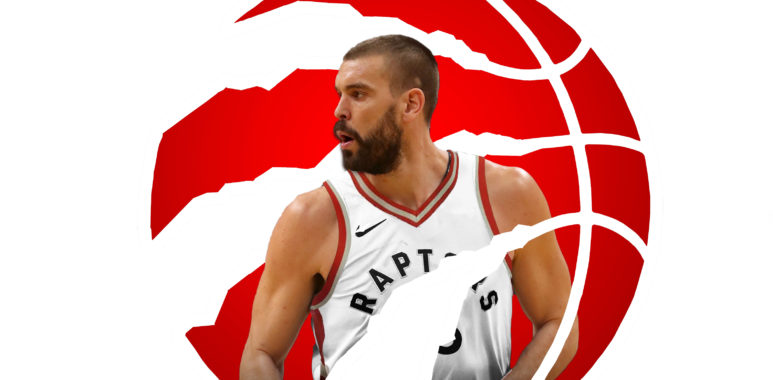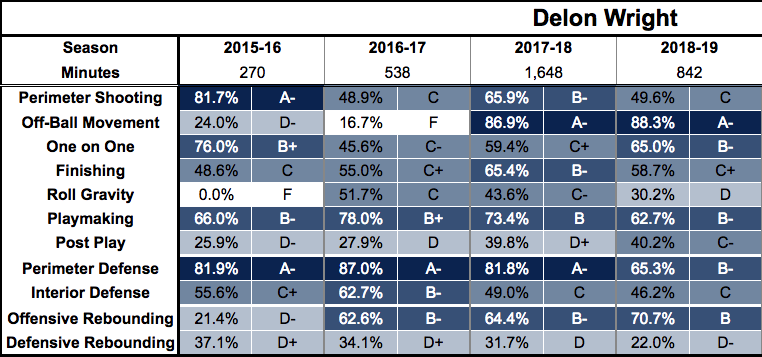
Examining the Memphis trade of Marc Gasol
Memphis has officially concluded an era. The Grizzlies shipped Marc Gasol north of the border to the Toronto Raptors. In return Memphis received Jonas Valanciunas, Delon Wright, C.J. Miles, and a 2024 second round pick.
For Grizzlies fans this return seems disappointing. Prior to the deal it was difficult to gauge what Gasol’s trade value was. Assessing this trade in the aftermath of the deadline still proves a difficult task. Memphis decided not to tear it down with a Gasol move. Instead there appears a clear strategy to remain competitive this season in an effort to get the top-8 protected pick owed to Boston to convey immediately.
What the Grizzlies did not receive is a juicy future draft pick (although it is conceivable any team could be awful 5 years from now and that second rounder could be damn near a first rounder). This can’t come as too much of a surprise since Gasol is most likely a negative asset at this point.
So how did Memphis do?
Gasol vs Valanciunas
Did Memphis actually upgrade at center?


This season Valanciunas is besting Gasol in eFG%, true shooting percentage, and rebound rate, rebounds per 36 minutes, and points per 36 minutes. It is important to note that Valanciunas has logged only 564 minutes due to a thumb injury. RPM and PIPM still favor Gasol, however.
Per our grading system, Gasol has the better assortment of career grades dating back to the 2013-14 season. Clearly Valanciunas was off to a poor start this year, but the 2017-18 season favors him over Gasol in a blowout. It is also more likely Valanciunas bounces back to his prior performance level than Gasol given the discrepancy in age (26 vs. 34).
You’ll likely notice Valancunias did not get off to a rocky start as an interior defender. His A grade will fit right in with the Grit n’ Grind culture. In fact, among players that have appeared in at least 25 games this season, and are defending at least 4 shots within 6 feet of the basket per game, Valanciunas is sporting the best defended field goal percentage on such shots in the entire league.
Valanciunas is a downgrade as a stretch big (read; he isn’t one), as well as a playmaker. He will never have enough time to develop the telepathic chemistry Mike Conley has with Gasol in the pick n’ roll. Still, Valanciunas will be an upgrade as a rolling big and offensive rebounder. The offensive rebounding contribution is huge, as Memphis ranks 29th in the league in offensive rebound rate.
Should Valanciunas end up the superior player in 2018-19, it shouldn’t come as much of a surprise. Valanciunas was projected to be significantly better this season based on PIPM data.

Delon Wright
Wright was the 20th pick of the draft in 2015 and will hit restricted free agency this summer. He is already in his age 26 season, as he came out of Utah as a 23 year old. He flashed an ability to be an efficient scorer last year, posting a 53% eFG% and 57.1% true shooting mark. However, he has regressed back to his prior efficiency levels this season.
Last year Wright ranked 19th among point guards in PIPM with a 1.11 figure. This season his PIPM has plummeted to -2.4, which ranks 90th (!) among point guards.
Per our grading system, 2017-18 was easily the best season of Wright’s career.

Last year Wright posted a B- or better grade in 6 of 11 categories, including an A- in two categories. This year those numbers stand at 5 of 11 and one. The two most significant regressions come in the two areas where he can impact a game the most; perimeter shooting and perimeter defense. Wright has dropped from a B- to a C in perimeter shooting, and an A- to a B- in perimeter defense.
Given this is the first season Wright has not sported an A- in perimeter defense, and his career grade is still a B+ including this year, he figures to see positive regression in this area. The more troubling aspect is his three-point shooting.
For his career, Wright is a 35.3% shooter from distance. That number seems to be buoyed, however, by his 36.6% mark from last season. In 2017-18 Wright took 153 attempts from beyond the arc and achieved that 36.6% success rate. The rest of his career combined has seen him shoot 33.8% on 133 attempts.
All of these samples are so small there isn’t much to be learned. He may have just had a hot 2017-18 season and be closer to a true 33% shooter from distance. Perhaps he is just volatile and is a mid 30’s shooter. One encouraging data point is that his free throw percentage his increased in every season of his career, spanning 74.3%, 76.4%, 82.9%, and 86.9%. Still, for Wright’s entire career he has attempted only 268 free throws.
The Money
Gasol’s $25.6 million player option for next season is no longer the Grizzlies’ problem. Alternatively, Memphis inherited a combined $26.3 million in player options between Valanciunas and Miles. Valanciunas’ option is worth $17.6 million while Miles’ is worth $8.7 million
It’s a good bet that both players opt in. Valanciunas may be a superior player to Gasol and making less money, but the center market continues to get even stingier. Clint Capela and Jusef Nurkic did their position mates no favors by agreeing to lesser deals. Valanciunas can play out his age 27 season, collect his $17.6 million, and then hit the market at age 28. Not the worst case scenario, unless he wants to rush off to a more competitive team, which, in that case, fair enough.
Miles may be more willing to decline his option to seek a more competitive team since next year will be his age 32 season. He may also want to chase the security of locking in more guaranteed money as soon as possible.
Miles is really struggling from three years this year, however. The career 35.9% shooter from distance his bricking his way to a 31.4% three-point mark this season. Entering the free agent market in the summer of 2019 wouldn’t exactly be striking while the iron is hot. Miles may be content to collect his $8.7 million, snipe his way through 2019-20, and hit free agency in the summer of 2020.
The Aggregate
Memphis didn’t guarantee that they would shed money in this move. Both Valanciunas and Miles could opt in and cost the team a bit more than what Gasol would have cost had he stayed and picked up his option for next year.
But both players can help Memphis win. Valanciunas may be a better player than Gasol right now, and the gap between them only figures to be larger next season as Gasol continues to age into his 30’s. If Miles can bounce back and start draining threes again that would fill a massive need on the Grizzlies’ roster.
The issue is whether or not you think Memphis should have tried to remain competitive and instead torn it down. Not bottoming out keeps teams in purgatory. The Grizzlies situation is a bit more complicated due to the first round pick they owe to Boston. The team wants that pick to convey as soon as possible so they don’t run the risk of eventually handing the Celtics a better pick in a better draft class.
It still remains a possibility that both players walk away in the summer.
As for Wright, Memphis gets a look at a former first round point guard. A team probably can’t learn too much about a player over the course of ~25 games, but at least they can get a peak. Wright will also be a reatrcited free agent so Memphis can match any offer he receives, which is an advantage. If Valanciunas and Miles walk, and Wright leaves on a big offer sheet the Grizzlies deem an overpay, then the team is left holding a 2024 second round pick in exchange for a franchise icon.
Even for a move that was clearly designed to maximize short-term success, there is a decent amount of risk involved. That’s just plain weird. On the other hand, what was Gasol really going to fetch? If the Charlotte deal truly fell apart because of squabbling over what protections would be on the first rounder headed back to Memphis, then the Grizzlies really blew it.
Otherwise this trade is probably fair value while being ostensibly underwhelming.
